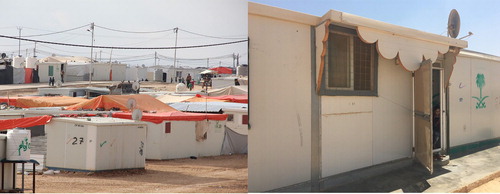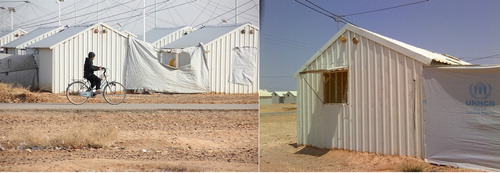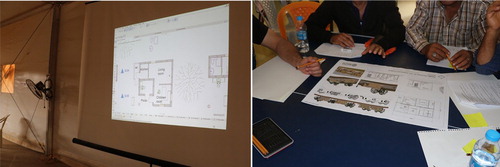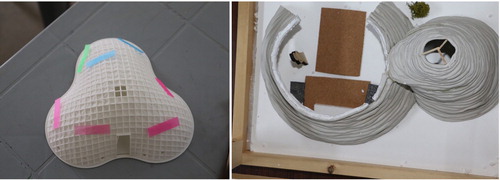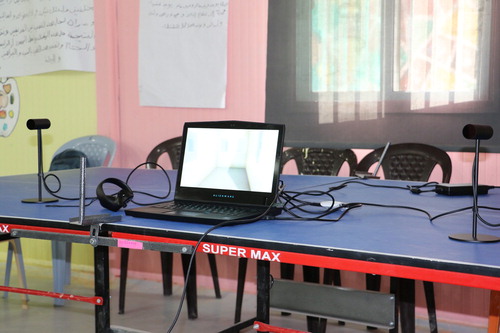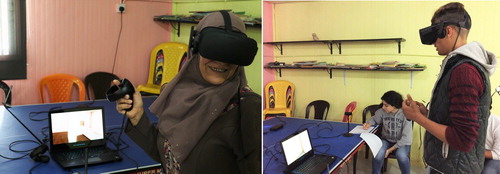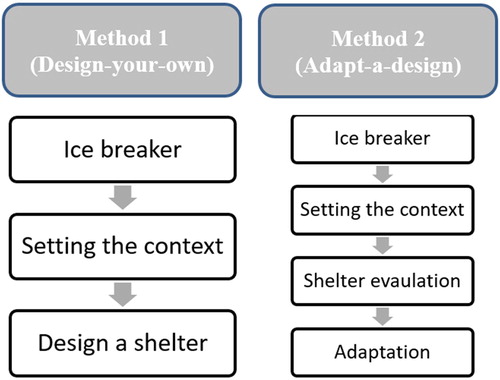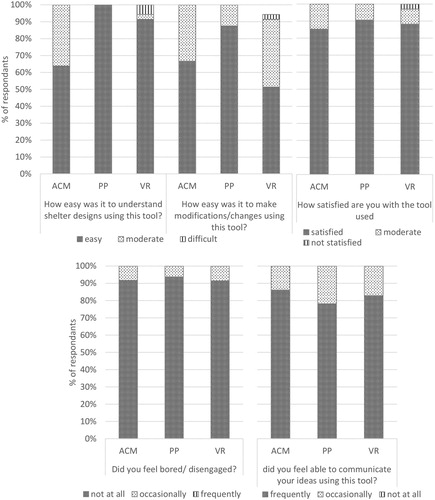ABSTRACT
Shelters for the displaced can suffer from socio-cultural incompatibility and significant levels of occupant dissatisfaction. Participatory design (PD) is known to help reduce such issues. This is the first study to investigate the effectiveness of different PD methods at engaging and capturing users’ needs for shelter design in refugee camps. It also aimed to identify which visualization tools are best at: engaging participants; communicating designs (e.g. concept, size and materials); and facilitating proposing modifications. This is a particularly large study with 16 workshops and 161 participants. Two PD methods were deployed: (i) design-your-own (where refugees proposed their ideal shelter); (ii) adapt-a-design (where refugees evaluated and modified pre-existing shelter designs). The shelters in (ii) were presented using three visualization tools: computer models, physical prototypes and virtual reality. Design-your-own proved less engaging and led participants to produce designs similar to their existing shelters. Adapt-a-design stimulated more dialogue and was more informative. Physical prototypes facilitated engagement in shelter modifications, computer models proved least able to communicate concepts, while virtual reality was best at communicating scale and size.
Introduction
The number of forcibly displaced people is at a record high of approximately 71 million (UNHCR, Citation2019). Of these, at least eight million refugees are housed in ‘temporary’ refugee camps (UNHCR, Citation2014). Displacement is generally long-term and can last several decades (UNHCR, Citation2004). It is known that the shelters provided are often unsuitable for prolonged habitation, despite the efforts from the humanitarian sector (Bashawria et al., Citation2014) and often ignore the cultural needs and local conditions (El-Masri & Kellett, Citation2001; Lizarralde & Davidson, Citation2006). Caia et al. (Citation2010) argue that shelter inadequacy can be a source of psychological stress, and as a result, people living in long-term encampment resort to making a lot of adaptations and modifications to their original shelter in pursuit of comfort and a sense of home (Hart et al., Citation2018).
The use of a participatory design (PD) process, also termed ‘co-design’ has been recommended by several authors for capturing user needs and requirements (Hussain et al., Citation2012; Luck, Citation2003). However, there are several challenges for PD implementation especially in cases that involve people from different countries or cultures (Holeman et al., Citation2017), as is the case of international humanitarian agencies co-designing with local communities.
In this study, PD was deployed in refugee camps in Jordan as a way of generating design solutions, with sixteen PD workshops conducted with 161 participants. The objectives of the workshops were: 1. Evaluate the effectiveness of selected PD methods and tools 2. Define shelter design metrics and typologies acceptable by the refugees to inform future temporary shelter solutions in displacement camps. This paper is limited to the findings from the first objective. A pilot study (of 36 subjects) was conducted with refugees and non-refugees in the United Kingdom (UK). Followed by workshops in two refugee camps in Jordan: Azraq and Zaatari.
Background
Context: temporary shelters for the displaced
There are two common approaches to providing temporary shelters: they are either standardized prefabricated units that are mass produced and shipped to the intended site; or built on site by the displaced populations or local workers under the supervision of local authorities or NGOs. Bashawria et al. (Citation2014) and Abulnour (Citation2014) gave an overview of current shelter design shortcomings. Issues such as thermal performance and cultural inadequacy are frequently reported (Barakat, Citation2003; Hadafi & Fallahi, Citation2010; Johnson, Citation2007). This inadequacy is ‘a result of unsuccessful strategies, misunderstandings about users’ real needs and misconceptions in dealing with local conditions and resources’ (Felix et al., Citation2013). This is regardless of whether the shelters were manufactured remotely or built on site.
In Jordan, Zaatari camp was established in 2012 and currently hosts 80,000 Syrian refugees. It is mainly compromised of imported caravan-like structures made of 40 mm polyurethane insulated panels with inner and outer surfaces of 0.35 mm steel sheets. Significant modifications have been made to the original shelters and to their arrangement in an attempt by the refugees to better their living conditions. For example, moving the caravans to create courtyards instead of the original grid layout (). On the other hand, Azraq camp consists of 13,500 shelters built onsite of corrugated metal sheeting with 10 mm of insulation. The shelters have only one window complemented by high-level ventilation openings in the roof gables made of short lengths of 152 mm waste pipe. These high-level openings have been permanently blocked by most families as they are a source of sand ingress during high winds, and their position makes it difficult to block and unblock them when needed. The perceived need for privacy by local NGOs and authorities informed the single-window provision. Prioritizing privacy over cross-ventilation has however resulted in high temperatures and significant thermal discomfort within the shelters (Albadra et al., Citation2017). Whilst moving the shelters was not possible in Azraq camp due to the shelters being fixed to the ground; modifications such as creating additional windows and adding shading elements have been made by the refugees (). Such design issues highlight the need to involve end-users in the design process.
Participatory design (PD)
PD attempts to actively involve stakeholders in the design process to align the result with their needs and aspirations and to ensure the product is usable. This approach is used in many fields, from software to architectural design, as a way of creating products or environments that are more appropriate to the users’ or inhabitants’ cultural, emotional, and practical needs. There is a long history of PD in architecture (Halsall, Citation1987; Luck, Citation2003; Sanoff, Citation2000; Towers, Citation1995). PD is credited with generating higher satisfaction rates among users. This is because it provides a perspicuous environment to practically understand what participants can add to the design, and to explore problems unforeseen by the architects (Luck, Citation2012). It has been suggested that designers create more innovative concepts when working within a participatory environment (Mitchell et al., Citation2015; Trischler et al., Citation2018). Furthermore, Bossen et al. (Citation2010) suggest that the benefits of PD exceed the enhancement of a product or an environment, as it benefits participants by empowering them through engagement and making their voices heard.
However, there are several obstacles for PD implementation; these include – but not limited to – participants’ inability to conceptualize their needs and requirements, their limited knowledge about drawings and designing, and, their lack of familiarity with the technology used in these PD processes (Heiskanen & Lovio, Citation2010; Tweed et al., Citation1992). When working with displaced people, PD can be even more challenging; Hussain et al. (Citation2012) argues that in order for PD projects to be successful in such territories, designers and organizations in charge need to understand the vast difference between doing this in their developed countries and doing it in such circumstances. For example, challenges include differences in cultural practices, language, location and access, time and effort needed to engender trust and engagement of participants, and availability of materials (Holeman et al., Citation2017).
Most of the literature on local participation in shelter provision in displacement scenarios, focuses on participation in reconstruction or on self-build housing after disasters, as in Barakat (Citation2003); Boen and Jigyasu (Citation2005); and Bouraoui and Lizarralde (Citation2013). For example, in the aftermath of Haiti earthquake 2010, beneficiaries were involved in the construction of ‘durable’ shelters and were responsible for upgrades (IFRC et al., Citation2012, p. 32). Schilderman and Lyons (Citation2011), made a very compelling argument for participation at all stages of the re-housing process after disaster. However, temporary shelters are perhaps seen as exactly that, temporary, and therefore little attention is given to their socio-cultural suitability, despite the fact that they end up being inhabited for years or decades. As a result, there is only a handful of studies that attempt to involve RIDP in the design of temporary shelters, for example, Sabie et al. (Citation2017) and Dabaieh and Alwall (Citation2018). Both studies were conducted with refugees living in developed countries (Canada and Sweden, respectively). This suggests the need for a deeper understanding of how PD as a scheme can be shaped for successful use in displacement settings.
PD methods and tools
Sanders et al. (Citation2010) explain that the terminology used in the literature to describe PD application is inconsistent. Terms such as tools, toolkits, techniques, methods and approaches are used in different contexts. In this paper, the terminology proposed by Sanders et al. (Citation2010) is followed. They define tools as the material components used in PD activities, for example, a deck of cards or a 3D mock-up, a toolkit is a collection of tools used together, while techniques describe how the tools and toolkits are used. A method is a combination of tools and/or techniques that are purposefully put together to achieve a defined goal.
As mentioned earlier, very few studies exist on PD for shelter design. In Sabie et al. (Citation2017) toolkits consisting of stencils, papers and predesigned templates were used to help refugees with sketching shelter designs. In Dabaieh and Alwall (Citation2018) a temporary housing design was proposed to Syrian refugees in Sweden using sketches following semi-structured interviews and feedback was gathered in an iterative process. However, more generally in the architectural practice, the tools used are referred to as ‘visualization tools’. Visualization tools fall under two categories, traditional and computerized; where traditional tools are pen and paper, maps, photographs and physical models. Computerized tools are illustrated in hypermedia (interactive multimedia), geographic information system (GIS) mapping, computer modelling: two-dimensional (2D) or three-dimensional (3D), and virtual reality (VR), (Al-Kodmany, Citation2001; Brown, Citation2003). Traditional visualization tools are favoured by some because they provide participants with the confidence of use, especially those who are not familiar with the technology, they are easily accessible and require the least experience, relatively low-cost and can allow a ‘hands-on’ experience (Kaplan & Kaplan, Citation1989). On the other hand, computerized tools are believed to provide users with more opportunity to understand and participate in the design process, (Saleh et al., Citation2016). Conversely, other studies highlight that 3D computer models could be misleading and unable of representing the reality (Van Schaik, Citation2010). Such conflicting opinions are also true in the case or VR; Kuliga et al. (Citation2015) argue that VR provides more realistic user responses to the design and the more it represents the real environment, the more realistic the response. While Breen et al. (Citation2003) mentioned that one of the VR drawbacks lies in it being often perceived as being too clean or perfect, which reduces the feeling of being close to reality. In addition, VR might be limiting in terms of access and doesn’t allow for the face to face interaction (Bishop & Rohrmann, Citation2003; Kuliga et al., Citation2015).
In this study, the aforementioned visualization tools are categorized according to the levels of investment required by NGOs, i.e. time and resources needed to prepare. This is because NGOs have limited resources, thus a high level of investment might be detrimental for PD use. Tools that are readily available and do not require ‘making’, such as using pen and papers, deck of cards, and plasticine can be categorized as level 1 because they require the least resources, effort and time to prepare. 2D and 3D architectural drawings produced using computer models are level 2, as this requires access to design software – this is expected to be available to shelter designers; level 3 is using physical prototypes that will require access to laser cutting machines, 3D printers or carpentry skills; and level 4 is using VR that requires specialized software, equipment and skills to create.
In terms of PD methods, PD can be deployed at several stages of an innovation process: from the initial exploration and problem definition (to help define the problem), through the initial ideas stage, to the development stage, and then to finally help evaluate the proposed solutions (Simonsen & Robertson, Citation2012). Different visualization tools maybe more suitable at each stage. For example, Al-Kodmany (Citation1999) compared the effectiveness of three visualization tools for neighbourhood planning; and found that GIS mapping and sketching were most effective for identifying problems, while computer photo-manipulation was most beneficial for exploring solutions to previously-defined design issues.
Considering the challenges for PD implementation mentioned earlier, and given the lack of time and resources available for aid agencies when designing temporary shelters; it is important to understand what methods, tools and corresponding level of investment is required to encourage active user involvement and help RIDP conceptualize their values and ideas in the design of their shelters.
Methodology
Sanders et al. (Citation2010) proposed a framework with three-dimensions for PD: form, that describes the kind of activities taking place between participants, different forms use different tools; purpose, describes why the tools are used, that is probing participants, priming participants, understanding participants’ current experiences, or generating ideas and designs; and context, to describe how PD tools and techniques are used for example face to face, online or in groups or individual, and where (setting and venue). In this research, we draw on the above framework when designing our methodology. Together these three dimensions define our methods as follows ():
Method 1: Form: ‘design-your-own’ focussed on giving participants a ‘blank canvas’ – Tools used were paper, pens and pencils, plasticine, Lego® and a kit-of-parts in which participants can tear up papers and insert them in a base with pre-engraved grid. Purpose: To generate ideas and designs, participants were asked to use any of these tools to conceptualize and articulate their ‘ideal’ shelter. Context: in groups of five. This method was one step further than asking the refugees a series of standard questions in order to capture their shelter needs and requirements and can be used at the early design stages to gather initial ideas.
Method 2: Form: ‘adapt-a-design’ utilized four pre-designed shelter typologies (deployable, modular, assemblage and freeform) presented using three different visualization tools that were developed after a pilot study: Architectural drawings and Computer Models (ACM), Physical Prototypes (PP), and an immersive Virtual Reality (VR) experience. Purpose: To generate ideas and designs, participants were asked to modify the proposed designs to suit their needs and requirements. Context: The ACM and PP tools were used in groups of five, the VR was an individual experience. This can be implemented after an initial design has been developed by the humanitarian agencies.
The main aim was to establish which of these two methods is best at achieving this purpose. The study also hypothesized as to whether increased sophistication of the methods and tools used, and consequently increased effort and investment from humanitarian agencies, has any impact on promoting direct, active engagement of RIDP, communicating design intent and shelter design features, and facilitating proposing of modifications to shelter designs.
To achieve this, data was gathered through recording the observations of the research team, participants’ feedback, and later analysis of final designs and video recordings of the workshops. Participants were encouraged to verbally articulate their thought processes as they proposed solutions or changes and these were captured through photos, quick sketches, modifications to the CAD/VR files and via video recording. Participants’ feedback was collected on the visualization tools used using an evaluation sheet. The questions on the evaluation sheet were about the participants’ ability to understand the design, ability to propose modification, and communicate ideas as a result of the visualization tool used, engagement and overall satisfaction. The research team also noted their observations on the visualization tools ability to communicate specific design features relating to the overall concept, size, and materials; the feedback process; and ability to facilitate modifications.
Pilot study
The pilot study was only concerned with Method 2 ‘adapt-a-design’ visualization tools. The aim was to test possible visualization tools in order to establish how they can be improved prior to use in camps, identify any issues with delivery and get an idea of the expected length of the workshops. Thirty-six participants aged 18–72 years were recruited through local contacts. They included refugees with previous camp experience, and non-refugees. None of the participants had architectural or engineering background. Four separate mixed-gender workshops were conducted at the University of Bath and each had nine participants. A shelter design was presented using four tools: (i) architectural drawings printed on paper on which participants were able to sketch suggested changes; (ii) 3D computer model projected on-screen, where the coordinator of the session made proposed changes to the projected model in real-time as directed by the participants; (iii) a physical prototype that was modifiable and allowed participants to make changes themselves; and (iv) a simple virtual reality experience that only allowed the participants to view the model with modifications suggested verbally. Each of these tools was used in separate sessions.
Apart from when using VR, most of the participants found difficulties in reconciling the scales and defining dimensions. Therefore, they attempted to relate the given dimensions to the room they were in, this was especially true in the architectural drawings sessions. Additionally, the majority of participants, particularly in the physical prototype session expressed their confusion regarding the materials used, thereby, many requested illustrations of materials by either physical samples or videos. In the VR session, participants proposed being able to make adjustments to either drawings or a computer model. This is likely due to the VR experience being limited to viewing with any modifications being suggested verbally by the participants.
Based on these findings, for the main study: a materials palette was produced and added to the physical prototypes tool; and a more complex VR ‘game’ application that allows participants to modify the design was developed. In addition, due to limited access time to the camps, the architectural drawings and computer models were combined due to their similarities, with the main difference being ‘printed’ or ‘projected on screen’ drawings.
Sampling
One hundred and sixty participants were initially recruited; 80 per camp – 40 males and 40 females (). However, during the workshops, a few participants dropped out due to commitments, while others joined later, resulting in 161 participants in total and the actual numbers per workshop as shown in .
Table 1. Initial sampling, methods and tools in each camp.
Table 2. Actual number of participants for each method in both camps, mean age and standard deviation SD, and mean time participants have lived in the camps.
The sampling rules were: participants should be over 18 years old, from different socio-economic backgrounds and regions across Syria and have different educational levels. In addition, for the VR workshops, the participants were requested to have no known medical issues, no sight problems, and female participants shouldn’t be pregnant. Single gender workshops were held in line with cultural and religious norms and to minimize gender-biased results. Each workshop had approximately ten participants that were split in two groups of five. Each workshop was supervised and coordinated by four members of the research team (two per group), including two Arabic speaking academics, similar to the refugees.
Sampling was undertaken in collaboration with UNHCR-Jordan and Care International. They have direct access to the refugees, and frequently recruit participants for various workshops and focus groups that take place in the camps. Having no active control over the recruiting process presented a few issues. For example, despite requesting that participants should be from different age groups and educational backgrounds, in the first workshop in Azraq camp, those selected were mostly young and educated females. In another, in Zaatari, the participants were all chosen randomly from the same neighbourhood in the camp. These issues were reported and avoided in the subsequent workshops.
Typologies and visualization tools
For the ‘adapt-a-design’ workshops, four main shelter typologies were identified through a literature review (Albadra et al., Citation2018; Felix et al., Citation2013; IFRC, Citation2013). These were: Deployable, in which shelters are delivered in small packaging to site and deployed, for example, a tent. Assemblage, where shelters can be flat-packed and assembled on site. Modular, in which shelters are delivered as a unit, for example, a mobile caravan. Freeform, where shelters are built on-site from local materials and can be free in form, for example, sandbag shelters (Cal-earth, Citation2019), see .
Figure 4. Examples of shelter typologies – (a) deployable shelter (Sheltair by Gregory Quinn); (b) Freeform (Superadobe structure by Cal-Earth, Image source: Flickr - DVIDSHUB); (c) Assemblage (Progresiva V.2 shelter by Mott-Macdonald & Fundacion Vivienda); (d) Modular (Caravans modular units).
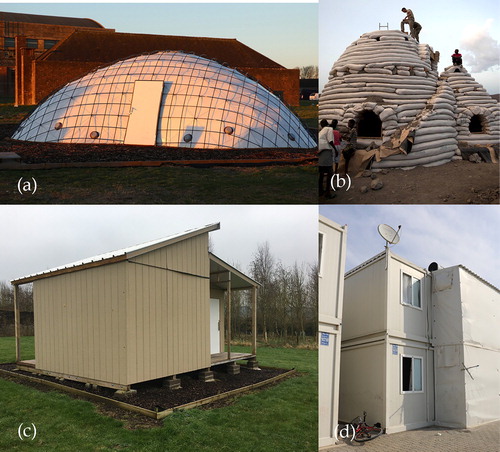
A design was created for each typology. These designs were developed to stage 3 (developed design) of RIBA Plan of Work, (Sinclair, Citation2013). The designs took different forms, internal layouts and materials palettes, and the degree to which each design could be modified inherently varied according to the design. However, they all had an approximately similar plot size. The feedback and adaptations to the typologies are outside the scope of this paper and subject of another.
Computer models, physical prototypes and virtual reality experiences were then created for each of the above-mentioned design typologies (with one exception in the case of VR – due to time and complexity of geometry of the proposed design, it was not possible to create a model for the freeform typology). The purpose of having different designs represented by all three visualization tools, was to enable a robust basis for comparison, by ensuring that the evaluation of each of the visualization tool is irrespective of the design proposed.
ACM: The computer models and architectural drawings were produced in Graphisoft’s ArchiCAD software for all four designs. Plans, sections, elevations and 3D illustrations were printed on A2 sheets at a scale 1:100. In addition to being projected onto a screen during the workshop. Modification to the projected computer model were made by a coordinator from the research team, as suggested verbally by the participants or drawn by them on the A2 sheets ().
PP: The physical prototypes for the four typologies were produced in scale 1:20. Furniture and human figures were added to help the participants with understanding the scale. A material palette was produced demonstrating the range of real and possible materials. The models were made from representative materials such as; MDF, plywood, clay and in one case 3D printed as illustrated in . The main characteristic of the physical models is that they were modifiable. However, the degree of flexibility in modifying each model was representative of the design concept for that shelter. In addition, participants were able to add new windows or doors using stickers, and choose alternative materials from the material palette.
VR: The virtual reality experience consisted of three separate custom-made VR applications, one for each of the three typologies. The participants were able to experience a realistic representation of the proposed shelters, both in terms of scale as well as the surrounding environment. Moreover, case-specific tools were developed for each VR experience as means of real-time personal expression, enabling the users to alter the original designs according to their preferences. The degree of flexibility varied for each typology, each time reflecting back to the design concept behind it. Specifically, the participants were allowed to simply navigate the deployable shelter, pick from a menu of preconfigured modular options after carefully walking through and exploring each option, and finally for the assemblage typology, they were able to actively assemble custom shelters in VR out of specified structural members, create openings and choose material finishes ( and ).
Figure 6. Physical prototypes – assemblage: (designed by the research team) participants were able to remove panels made of plywood and re-insert them in created channels.
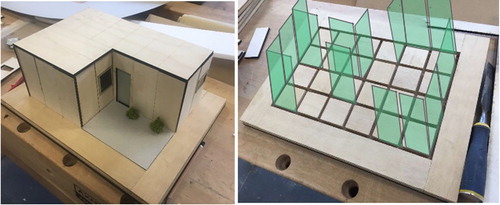
Figure 7. Physical prototypes: left, deployable (Sheltair designed by Gregory Quinn), participants were able to modify the internal layout; right, modular (designed by the research team), participants were able to re-arrange the units and create new configurations. Stickers were used to propose the location of any new windows.

Deployment
In the ‘design-your-own’ workshops, participants were split in two groups of approximately five. The workshop started with an ice breaker, in which background information of each participant were recorded and participants were asked to draw plans of their current shelters in order to get them familiar with sketching and thinking in plans. This was followed by setting the context, here the aims, objectives and constraints of the exercise were explained, it was made clear to the participants that taking part in the workshop will not result in any changes to their current shelters. Rather they were asked to imagine a scenario in which they have just arrived to the camps and design a suitable temporary shelter. It was also important that participants’ expectations were constrained within the remit of this study, i.e. functional temporary shelters, rather than the desire for permanent homes, to achieve this the shelter size was limited to UNHCR rules of 3.5 m2/person, and the material palette was restricted to what is allowed in the camps (e.g. bricks and concrete blocks are banned). The next activity was design a shelter, in which each group was asked to use any of the tools provided – paper and pencils, plasticine, Lego® or the kit of parts to design a temporary shelter that would suit their needs. To help with the designing process, four stages of design/detailing were suggested. In the first the participants were guided to start with designing layouts, this was then followed by positioning of openings, stage three was to choose materials, and lastly site positioning in relation to neighbours. Revisiting and reflecting on a ‘completed’ stage was permitted and encouraged. The workshops’ activities took approximately two hours to complete ().
Likewise, for the ‘adapt-a-design’ ACM and PP workshops, participants working in groups of five were asked to evaluate the typologies. The workshop’s agenda consisted of, an ice breaker and setting the context, similar to the aforementioned. Followed by shelter evaluation, in which each group were presented with one of the typologies and were requested to jointly agree and give feedback on the design. Then, adaptation, where groups were asked to propose modifications to the original design and adapt it to their needs. The last two steps were repeated for each of the four shelter typologies, meaning each group evaluated and modified all four typologies, resulting in 32 modified designs. Lastly, each participant was requested to feedback on the workshop’s tool using evaluation sheets. Each workshop lasted approximately four hours including a lunch break, with two design typologies being evaluated in the morning and two in the afternoon. This seemed to be the maximum that the participants could take.
In the VR workshops, the same sequence was followed however, due to the nature of the VR experiment, it was an individual experience, rather than in groups. Each participant was able to evaluate and make or suggest modifications to one design chosen at random. I.e. one design per one participant.
Similarly to the ‘design-your-own' workshops, the modification process was categorized into four stages of design in order to understand the ability of each tool in communicating different design aspects.
Findings
The results are summarized below firstly by comparing the two methods overall effectiveness at achieving the defined purpose of these workshops and secondly by comparing the visualization tools ability to promote engagement of RIDP, communicate design intent and features, and facilitate proposing of modifications to shelter designs.
‘Design-your-own’ vs. ‘adapt-a-design’
In the ‘design-your-own’ workshops, eight shelter designs were produced in total. Sketching was the most common tool and was chosen by four groups, two groups chose plasticine and two groups chose the kit of parts. Lego® was only used in one workshop by the two groups to propose a site plan. Participants were initially reluctant to engage and pick up a pen or use any of the other tools. Phrases such as, ‘I can’t design’ or ‘I can’t sketch’ were frequently mentioned, particularly in female groups. The workshops’ coordinators had to keep encouraging the participants to express their thoughts and attempt to design.
Despite the constraints explained when setting the context, participants in Zaatari camp designed larger shelters with several rooms in a similar manner to the adaptations they have made to their current shelters.
All eight groups which participated in the ‘design-your-own’ workshops across both camps, designed variations of their current shelters and used the locally available materials in the camps such as metal sheeting, sandwich panels (similar to those used to form the caravans used in Zaatari), or adobe – under the caveat; ‘if allowed by the authorities’. Despite them raising objections about these materials in various dialogues and during the other workshops ( and ).
Figure 12. Example of ‘design you own’ from Zaatari camp, caravans were arranged around a courtyard in a similar manner to common existing layouts in the camp.
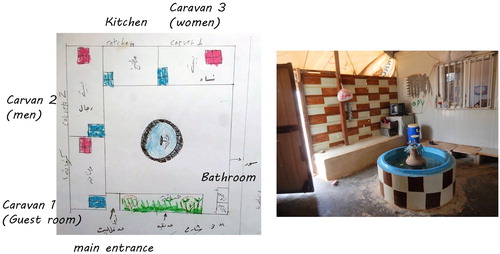
Figure 13. Example of ‘design you own’ from Azraq camp, shelters took rectangular shape with a side garden similar to existing adaptations in this camp.
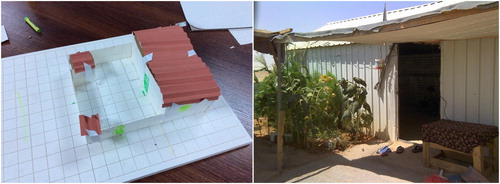
It was clear that participants reverted to what is familiar in their current setting. In other words, the resulting designs were merely an enhancement to their current shelters. In the free-design exercise, participants’ creativity seemed to be limited. This is in contrast, to the ‘adapt-a-design’ workshops where base-case designs were proposed, and the participants were asked to feed-back and modify these designs. Participants in ‘adapt-a-design’ workshops were much more engaged and did not need active encouragement to participate. Whilst it could be argued that the final solutions generated in the second method are also an enhancement to the proposed designs rather than innovative solutions; these workshops stimulated significantly more dialogue and resulted in a more informative process regarding the participants’ needs and preferences and thus were better at capturing this.
Visualization tools
Engagement and interest in the activities were on average very high, and participants reported having a positive experience. This is despite no rewards being offered and participants being well-aware that their contribution would not result in any direct benefit or changes to their current shelters. Common verbal feedback given after the workshop included:
‘we have really enjoyed today’
‘we are glad our opinions are being considered’
‘we were inspired by these ideas’ and ‘you’ve given us something to do in our day’
However, age and gender certainly played some role in how engaged participants were. For example, all young participants (male and female) were very engaged, while older women were on occasions less interested. Early drop outs were slightly more common in female groups, citing responsibilities such as picking up children from school, preparing lunch and even to attend a job interview as reasons. In addition, several women attended with their young children resulting in some distraction during the workshops. The exception to this was the VR workshops where both male and female participants across all age groups were very interested in participating. This is possibly because of the curiosity to try out a new high-tech experience, but also because it took less time to run. Given that it was an individual experience, participants in the VR group had to attend either a morning or an afternoon session – as opposed to the whole day participation needed in the ACM and PP workshops.
Each participant was handed a one-page evaluation sheet at the end of the ‘adapt a design’ workshops, the questions related to the visualization tool used and not the shelters presented during the workshops. Despite reiterating this several times, several participants kept referring back to the shelter designs when answering the questions, and therefore it became evident that the ease with which they understood a design typology using any of the three visualization tools related to the complexity of the design itself. It should be noted that many of the participants were illiterate and the evaluation sheets had to be filled in by the Arabic speaking researchers on their behalf. The results of the 125 evaluation sheets collected are summarized in . Overall, PP had the highest approval levels with 100% of respondents reporting that they found it easy to understand designs using this tool, (compared to 64% for ACM and 91% for VR); and 88% found it easy to propose modifications (compared to 67% for ACM and 51% for VR). In terms of satisfactions and engagement, the responses were highly positive for all tools. However, with regards to ability to communicate ideas, only 78% felt frequently able to communicate their ideas using PP, 86% using PM and 83% using VR. It is also worth noting that no negative answers (e.g. difficult/not satisfied) were given for ACM and PP, whilst a small percentage (3–6%) gave negative responses for VR. This is possibly due to the difficulty some found in navigating the VR application.
Based on the evaluation sheets () and the research team observations (), the following results were found:
ACM: Complex geometries (such as the deployable typology) were harder to understand than more familiar designs. Several participants expressed that they were only able to understand the designs because of the 3D images rather than the plans and sections. However, this varied significantly among participants, for example, men who had worked in building related trades such as construction, carpentry and plumbing were readily able to understand architectural drawings. In addition, difficulties in understanding the real-life scale of the shelters were reported, especially the height, despite the models including furniture and figures and dimensions being written down. In general, when making modifications, participants were asked to discuss options then verbally suggest agreed changes so that the workshop coordinator could modify the computer model in real-time. While most were happy to interact with the on-screen 3D model, pointing and making verbal suggestions, several participants, particularly among men, resorted to drawing on the plans to express their desired changes, these were then translated onto the screen by the workshop coordinator. It seems, however, that although an interactive 3D computer model is a good way of illustrating a design, it removes the agency from the participants as they are unable to use the design software themselves, and hence several felt the need to sketch.
PP: Participants were quick to understand the design concepts. Questions asked by them were mainly about materials and the building techniques used. Comments made such as ‘is the shelter going to have gaps between the panels like in the model’ in the case of the assemblage typology; and liking the quality of the freeform sandbag model to the actual built quality of these kinds of structures, demonstrate the issues presented by the simplification of the prototypes in this method, as it was assumed to be representative of reality. This illustrated the difficulty in understanding abstractions. When making modifications, participants were restricted to the tools and parts available. However, they were happy to improvise and made use of whatever was available to help them to visualise their ideas. For example, tearing paper up and creating additional partitioning or roofing with it. However, this may have resulted in the slightly lower satisfaction rate with regards to their ‘ability to communicate ideas’ using this method.
VR: No correlation between gender, education or age with ability to use and manoeuvre with the VR game was observed; this was more related to personal abilities only. This is contrary to common assumptions that younger generations may pick up such technology more quickly or be more at ease with its use. Several participants complained of headaches or feeling dizzy and when this occurred the exercise had to be stopped sometimes. For the same reason, it was not possible to have lengthy discussions with the participants whilst they were using the equipment. As participants viewed the design, they were asked to evaluate the shelter. At times it felt like the coordinators had to rush through the shelter evaluation questions before participants started feeling discomfort. Many participants were not happy to continue to the ‘making adaptation’ stage of the application. Sometimes participants reacted with awe, but it wasn’t clear whether this was because of the VR experience or admiration of the shelter they were virtually experiencing. So whilst overall, the participants enjoyed the VR experience it wasn’t as effective in obtaining feedback on shelter typologies. Judging by the absence of questions on shelter size compared to the other tools; the main plus point of the VR was that participants were able to experience the shelter in terms of height and space and were able to relate to the size of the shelter better than in other tools.
Table 3. Summary of key observations made by workshop coordinators for each of the three visualization tools.
Discussion
One of the main motives for promoting participatory design in displacement contexts is to give refugees and internally displaced people (RIDP) a sense of ownership and belonging by involving them in their shelter design. This is known to increase satisfaction and it can also help mitigate the significant costs associated with later adaptations to shelters. In this study, PD workshops were proposed using Sanders et al. (Citation2010) framework to define our methodology. The purpose of the workshops was to generate ideas and designs in line with refugees’ desires and needs. The study was inspired by the existing situation in Azraq and Zaatari refugee camps whereby refugees have made significant adaptations to their shelters, and it builds on our previous extensive work in these camps that demonstrated the need for a more active approach to shelter design input. Therefore, this study attempted to involve the refugees in two ways, in the first by giving them the tools to design their ideal shelter (had they been given the chance; what sort of shelter would they have developed?). In the second, they were presented with four predesigned shelters and asked for their feedback and to suggest modifications to improve these shelters.
Other forms of participatory design could be used for different purposes, for example, the use of participatory design board games or theatrical acts to understand users’ current experiences are common in the literature (Brandt, Citation2006). Indeed, further studies exploring other forms of participation are needed to establish how to best engage with and capture the needs of this marginalized population. In this study, which is the first to explore this, we have found that conducting a PD workshop after an initial design has been developed is more beneficial and is a better use of available time and resources to humanitarian agencies, rather than expecting the refugees to create a solution on their own or answer an abstract question on what they prefer.
This study also explored suitable visualizing tools for representing shelter designs, in order to engage with RIDP, communicate designs features and allow the proposing of modifications. Breen et al. (Citation2003) argued that physical prototyping is still an important asset in design representation despite advances in computerization. Having a physical model to play with did indeed result in active participation. However, as the models were simplistic in their representation, misunderstandings regarding textures and materials were common. The use of a materials palette showcasing samples of the real-life materials helped overcome these issues, and as such it seems necessary to have samples of real materials to aid the effectiveness of this visualization tool. On the other hand, the typologies presented using architectural computer models (ACM) and the virtual reality (VR) had higher levels of detail, including material realism. This resulted in the participants, on occasions, being somewhat distracted by the details. This was similar to the pilot study where participants’ attention was diverted to unnecessary details, which shaped their perception of the design. For instance, linking the shelter size with the number of mattresses provided and the availability of electricity by the presence of a light bulb on the ceiling. This is in line with the findings of (An, Citation2005) that argues that high level of detail in early design stages might shift users’ attention to irrelevant matters at that stage. This presents a conflict between the difficulty in understanding abstracts and being too specific when shown detailed designs. During the ACM workshops, more questions were asked by the participants about the more complex geometries and it required the coordinators of the workshop to explain certain elements. Answers such as ‘yes it was easy to understand the design using this method because you explained it really well’ were common. However, this was not the case with VR, the experience rendered all the designs ‘self-explanatory’ and less input was needed from the coordinators.
It was evident that regardless of the visualization tool used, that when presented with a design, all the workshops were very informative. Therefore, the most suitable visualization tool for any given participatory workshop will depend on the sub-objectives of the workshop. For example, VR will provide a better understanding of a shelter’s characteristics, e.g. size and height. While physical prototypes (PP) will allow for more interactions and hands-on approach. ACM on the other hand might be the most convenient option for humanitarian agencies as it requires the least resources and time to create. However, overall PP had the highest approval levels from participants in terms of understanding design concept, making modifications and engagement, and therefore its use is recommended if resources allow.
Lastly, designing together in groups of five forced the participants to collectively consider trade-offs and compromises based on collective desires or proscriptions. This however is not possible using VR. In addition, it should be noted that transparency and managing expectations were important elements for the success of the workshops; refugees were well-aware that, in our case, participation will not result in any tangible changes in their living conditions; yet they were willing to spare time and contribute their ideas and were appreciative of the opportunity. Such transparency at the start of any PD workshops helps with encouraging engagement as well as managing expectations and setting design constraints.
Conclusions
Temporary shelters, whether mass-manufactured or built on-site are provided in a top-down approach. As a result, they suffer from significant occupant dissatisfaction and have detrimental impact on occupants’ health and wellbeing. PD is an effective tool to capture users’ needs and increase satisfaction levels. It can be deployed at any or several stages of the design process, however, there are several challenges to its implementation, especially in displacement contexts. Humanitarian agencies have limited time and resources and therefore providing a ‘shelter’ is often prioritized over the cultural and environmental suitability of these shelters. A PD approach is therefore rarely considered – participation in displacement contexts is limited to participation in the construction of self-built housing after disaster.
This paper presents the first study to investigate the effectiveness of different PD methods at engaging and capturing users’ needs for shelter design in refugee camps. It is hoped that by establishing how PD can be shaped for effective use in displacement settings; it would encourage its adoption by humanitarian agencies.
Conducting this type of research in refugee camps can be very challenging due to issues of access and communication. Access issues encountered included, (i) difficulties in obtaining permits from both the humanitarian organizations operating in the camps and local governments; (ii) limited permitted time in the camps; (iii) a lack of control over participants’ sampling and recruitment; and (iv) a lack of control over venue conditions. Communication challenges included (i) having to develop an understanding and awareness of social signals or norms. For example, participants being complimentary of shelters, in order not to offend the research team, meant that we had to state that we were not the shelters’ designers and encourage the participants to express their real opinions. (ii) Conflicting local linguistic expressions, due to the participants being from different regions in Syria, each having their own local vocabulary to describe building materials or activities.
This study has found that the ‘adapt-a-design’ form was more effective than ‘design-your-own’ in capturing refugees needs and desires as it stimulated more discussions and engagement. Participants were more resourceful and better able to translate their ideas, thus resulting in a more informative process, when they were presented with an initial design or concept to work with. Sketching was the most common tool used by the participants in the ‘design your own’ workshops. Computer models, physical prototypes and virtual reality were used in the second method. Each of these visualization tools presented limitations and opportunities. However, PP had the highest overall approval levels as a tool by participants.
Data access statement
The data that support the findings of this study are openly available at (https://doi.org/10.15125/BATH-00687).
Acknowledgements
The authors acknowledge the contributions of Maria Aceytuno and Maria-Christina Manousaki to the development of the VR tool. In addition to Jahnavi Kantamneni for her contribution to creating the kit of parts; and to Gergory Quinn for providing us with 3D computer model of his design and allowing us to use it in our research. Lastly, we thank UNHCR and Care International for facilitating this work and all the refugee participants for their time and input. This project is funded by EPSRC/GCRF (EP/P029175/1).
Disclosure statement
No potential conflict of interest was reported by the author(s).
Additional information
Funding
References
- Abulnour, A. (2014). The post-disaster temporary dwelling: Fundamentals of provision, design and construction. HBRC Journal, 10(1), 11–12.
- Albadra, D., Coley, D., & Hart, J. (2018). Toward healthy housing for the displaced. The Journal of Architecture, 23(1), 115–136. https://doi.org/10.1080/13602365.2018.1424227
- Albadra, D., Vellei, M., Coley, D., & Hart, J. (2017). Thermal comfort in desert refugee camps: An interdisciplinary approach. Building & Environment, 124, 460–477. https://doi.org/10.1016/j.buildenv.2017.08.016
- Al-Kodmany, K. (1999). Using visualization techniques for enhancing public participation in planning and design: Process, implementation, and evaluation. Landscape and Urban Planning, 45(1), 37–45. https://doi.org/10.1016/S0169-2046(99)00024-9
- Al-Kodmany, K. (2001). Visualization tools and methods for participatory planning and design. Journal of Urban Technology, 8(2), 1–37. https://doi.org/10.1080/106307301316904772
- An, K. (2005). Implementation of real-time landscape visualisation for planning process. In E. Buhmann, P. Paar, I. Bishop & E. Lange (Eds.), Trends in real-time landscape visualization and participation. Proceedings at Anhalt University of Applied Sciences 2005 (pp. 184–194). Herbert Wichmann Verlag.
- Barakat, S. (2003). Housing reconstruction after conflict and disaster. Humanitarian policy group. Network Papers, 43, 1–40.
- Bashawria, A., Garritya, S., & Moodleya, K. (2014). An overview of the design of disaster relief shelters. Procedia Economics and Finance, 18, 924–931. https://doi.org/10.1016/S2212-5671(14)01019-3
- Bishop, I. D., & Rohrmann, B. (2003). Subjective responses to simulated and real environments: A comparison. Landscape and Urban Planning, 65(4), 261–277. https://doi.org/10.1016/S0169-2046(03)00070-7
- Boen, T., & Jigyasu, R. (2005, December 5). Cultural considerations for post disaster reconstruction post-tsunami challenges. In UNDP Conferences (pp. 1–10).
- Bossen, C., Dindler, C., & Iversen, O. (2010, November). User gains and PD aims: Assessment from a participatory design project. Proceedings of the 11th biennial participatory design conference. Sydney, 141–150. https://doi.org/10.1145/1900441.1900461
- Bouraoui, D., & Lizarralde, G. (2013). Centralized decision making, users’ participation and satisfaction in post-disaster reconstruction: The case of Tunisia. International Journal of Disaster Resilience in the Built Environment, 4(2), 145–167. https://doi.org/10.1108/IJDRBE-02-2012-0009
- Brandt, E. (2006, August 1–5). Designing exploratory design games: A framework for participation in participatory design? Proceedings of the ninth participatory design conference 2006. Trento, Italy.
- Breen, J., Nottrot, R., & Stellingwerff, M. (2003). Tangible virtuality—perceptions of computer-aided and physical modelling. Automation in Construction, 12(6), 649–653. https://doi.org/10.1016/S0926-5805(03)00053-0
- Brown, A. G. (2003). Visualization as a common design language: Connecting art and science. Automation in Construction, 12(6), 703–713. https://doi.org/10.1016/S0926-5805(03)00044-X
- Caia, G., Ventimiglia, F., & Maass, A. (2010). Container vs. dacha: The psychological effects of temporary housing characteristics on earthquake survivors. Journal of Environmental Psychology, 30(1), 60–66. https://doi.org/10.1016/j.jenvp.2009.09.005
- Cal-Earth. (2019). CalEarth. Retrieved December, 2019, from https://www.calearth.org/
- Dabaieh, M., & Alwall, J. (2018). Building now and building back. Refugees at the centre of an occupant driven design and construction process. Sustainable Cities and Society, 37, 619–627. https://doi.org/10.1016/j.scs.2017.11.002
- El-Masri, S., & Kellett, P. (2001). Post-war reconstruction: Participatory approaches to rebuilding the damaged villages of Lebanon: A case study of al-Burjain. Habitat International, 25(4), 535–557. https://doi.org/10.1016/S0197-3975(01)00023-6
- Felix, D., Branco, J. M., & Feio, A. (2013). Temporary housing after disasters: A state of the art survey. Habitat International, 40, 136–141. https://doi.org/10.1016/j.habitatint.2013.03.006
- Hadafi, F., & Fallahi, A. (2010). Temporary housing Respond to disasters in developing countries e case study: Iran-Ardabil and Lorestan Province earthquakes. World Academy of Science, Engineering and Technology, 66, 1536–1542.
- Halsall, B. (1987). Building democracy – housing co-operatives in Merseyside. Co-operative Development Services.
- Hart, J., Paszkiewicz, N., & Albadra, D. (2018). Shelter as home? Syrian homemaking in Jordanian refugee camps. Human Organization, 77(4), 371. https://doi.org/10.17730/0018-7259.77.4.371
- Heiskanen, E., & Lovio, R. (2010). User–producer interaction in housing energy innovations: Energy innovation as a communication challenge. Journal of Industrial Ecology, 14(1), 91–102. https://doi.org/10.1111/j.1530-9290.2009.00196.x
- Holeman, I., Blake, E., Densmore, M., Molapo, M., Ssozi, F., Goodman, E., Medhi Thies, I., & Wyche, S. (2017, May 6–11). Co-Design across borders special interest group. Proceedings of the 2017 CHI conference extended abstracts on human factors in computing systems, Denver, CO, USA, 1318–1321.
- Hussain, S., Sanders, E. B. N., & Steinert, M. (2012). Participatory design with marginalized people in developing countries: Challenges and opportunities experienced in a field study in Cambodia. International Journal of Design, 6(2).
- IFRC. (2012). Haiti – 2010 – earthquake – overview. Retrieved May 2019, from http://shelterprojects.org/shelterprojects2010/A04-A11-Haiti2010.pdf
- IFRC. (2013). Post disaster shelter: 10 designs.
- Johnson, C. (2007). Impacts of prefabricated temporary housing after disasters: 1999 earthquakes in Turkey. Habitat International, 31(1), 36–52. https://doi.org/10.1016/j.habitatint.2006.03.002
- Kaplan, S., & Kaplan, R. (1989). The visual environment: Public participation in design and planning. Journal of Social Issues, 45(1), 59–86. https://doi.org/10.1111/j.1540-4560.1989.tb01533.x
- Kuliga, S. F., Thrash, T., Dalton, R. C., & Hölscher, C. (2015). Virtual reality as an empirical research tool—exploring user experience in a real building and a corresponding virtual model. Computers, Environment and Urban Systems, 54, 363–375. https://doi.org/10.1016/j.compenvurbsys.2015.09.006
- Lizarralde, G., & Davidson, C. (2006). Learning from the poor. In D. Alexander (Ed.), Post-disaster reconstruction: Meeting stakeholders’ interest. Firenze University Press.
- Luck, R. (2003). Dialogue in participatory design. Design Studies, 24(6), 523–535. https://doi.org/10.1016/S0142-694X(03)00040-1
- Luck, R. (2012). Kinds of seeing and spatial reasoning: Examining user participation at an architectural design event. Design Studies, 33(6), 557–588. https://doi.org/10.1016/j.destud.2012.06.002
- Mitchell, V., Ross, T., Sims, R., & Parker, C. J. (2015). Empirical investigation of the impact of using co-design methods when generating proposals for sustainable travel solutions. CoDesign, 12(4), 205–220. https://doi.org/10.1080/15710882.2015.1091894
- Sabie, S., Easterbrook, S., Munteanu, C., Singh, K., St-Cyr, O., & Hashim, F. (2017, May 6–7). Participatory shelter design for displaced populace: Reflections from a user study. HCI across Borders Symposium, Denver, CO, USA.
- Sanders, E. B-N., Brandt, E., & Binder, T. (2010, November 28 – December 3). A framework for organizing the tools and techniques of participatory design. In K. Bødker, T. Bratteteig, & D. Loi (Eds.), Proceedings of the Partcicipatory Design Conference 2010: PDC 2010 Participation: the Challenge (pp. 195–198). Association for Computing Machinery (ACM).
- Sanders, E; Brandt, E; and Binder, T. (2010). A framework for organizing the tools and techniques of participatory design. In Proceedings of the 11th Biennial participatory design conference (PDC ‘10). ACM, New York, NY, United States, 195–198.
- Sanoff, H. (2000). Community participation methods in design and planning. John Wiley & Sons.
- Schilderman, T., & Lyons, M. (2011). Resilient dwellings or resilient people? Towards people-centred reconstruction. Environmental Hazards, 10(3–4), 218–231. https://doi.org/10.1080/17477891.2011.598497
- Simonsen, J., & Robertson, T. (2012). Routledge international handbook of participatory design. Routledge.
- Sinclair, D. (2013). RIBA plan of work 2013 overview. RIBA.
- Towers, G. (1995). Building democracy – community architecture in the inner cities. UCL Press.
- Trischler, J., Pervan, S. J., Kelly, S. J., & Scott, D. R. (2018). The value of codesign: The effect of customer involvement in service design teams. Journal of Service Research, 21(1), 75–100. https://doi.org/10.1177/1094670517714060
- Tweed, C., Woolley, T., Bevast, B. T., & Ireland, N. (1992). User participation in design; Techniques for dialogue. Arch. Comport./Arch. Behav, 8, 253–264.
- UNHCR. (2014). Statistical yearbook 2014, 14th edition, statistical annexes. Retrieved May 2019, from http://www.unhcr.org/statisticalyearbook/2014-annex-tables.zip
- UNHCR. (2019). Figures at a glance. Retrieved May 2019, from http://www.unhcr.org/figures-at-a-glance.html
- UNHCR executive committee of the high commissioner’s programme. (2004). Protracted refugee situations. Retrieved April 14, 2017, from http://www.unhcr.org/40c982172.pdf
- Van Schaik, P. (2010). Using interactive 3-D visualization for public consultation. Interacting with Computers, 22(6), 556–568. https://doi.org/10.1016/j.intcom.2010.06.002

